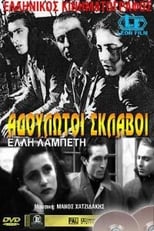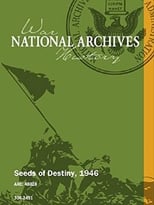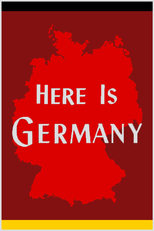War
Osvobozhdennaya Chekhoslovakiya
February 8, 1946

Liberated Earth
February 2, 1946
After the liberation of the Kuban by the Soviet Army troops, farmers return home and begin to restore the destroyed economy. Under the leadership of the young chairman, Nadiezdha Pritulyak, growers are working with great enthusiasm.
Jungle Mariners
January 15, 1946
A party of eight Royal Marines patrol the jungle in the South East Asia Command Area.
Failure of a Strategy
January 11, 1946

Occupied Territory
January 1, 1946
Bezet gebied ('Occupied Territory') is the first feature-length Dutch fiction film to deal with World War II, and was made in a documentary style. Dutch diva Ellen Vogel is stunning in her feature debut, in spite of the mediocre image quality. We're showingt a digitalisation of a version that underwent analogue conservation in 1983. It's not a restoration, so the image quality is average.
From Paris to the Rhine
January 1, 1946
A short documentary made for the British government illustrating the Allied war effort between the liberation of Paris and the arrival at the river Rhine. Part of a series that ran from the invasion of Italy to V-E Day.
From D-Day to Paris
January 1, 1946
A short documentary illustrating the Allied landing at Normandy and the course of the war running up to the liberation of Paris. Part of a series that ran from the invasion of Italy to V-E Day
From Italy to D-Day
January 1, 1946
A short documentary made for the British government covering the Allied war effort in Europe in the year leading up to D-Day. Part of a series that continues to V-E Day.

Unsubdued Slaves
January 1, 1946
On the eve of World War II in Athens, a troupe of young actors plans to put on William Shakespeare's, A Midsummer Night's Dream. However, the outbreak of war changes everything.

Effects of the Atomic Bomb on Hiroshima and Nagasaki
January 1, 1946
This was the only documentary made in the aftermath of the atomic bombings of 1945. Japanese filmmakers entered the two cities intent on making an appeal to the International Red Cross, but were promptly arrested by newly arriving American troops. The Americans and Japanese eventually worked together to produce this film, a science film unemotionally displaying the effects of atomic particles, blast and fire on everything from concrete to human flesh. No other filmmakers were allowed into the cities, and when the film was done the Americans crated everything up and shipped it to an unknown location. That footage is now lost. However, an American and a Japanese filmmaker each stole and hid a copy of the film, fearful that the reality of Hiroshima and Nagasaki would be hidden from history. Eventually, these prints surfaced and became our only precious archive of the aftermath of nuclear warfare -- a film that everyone knows in part, yet has rarely seen in its entirety.

Seeds of Destiny
January 1, 1946
Oscar winning postwar propaganda film in support of the United Nations Relief and Rehabilitation Administration. Strident but poignant, focusing on children. The film surveys the Nazi/Japanese atrocities, post-war devastation and the early relief efforts. This film was responsible for raising over $200,000,000, making it a top moneymaking film. Preserved by the Academy Film Archive in 2005.

Simple People
December 31, 1945
A 1945 Soviet war film which, along with the second part of Eisenstein's Ivan the Terrible was harshly criticized by Andrei Zhdanov and banned. A version of the film, released in 1956 during the Khrushchev Thaw, was disowned by director Grigori Kozintsev because the reediting was done without his participation.

Here Is Germany
December 31, 1945
A "know-your-enemy" propaganda film similar to "Know Your Enemy: Japan" and "My Japan", films about Japan with the same objective. It contains a history of the prelude to WW II, the death camps and other Nazi war crimes, and commentary on the character of the German people. Directed by Frank Capra, this film is in essentially the same format as his "Why We Fight" series. It was intended to be shown to American troops participating in the invasion and occupation of Germany. But by the time it was ready, events had overtaken it -- Germany was already well on its way to falling -- so the film was shelved. Although it is readily available for public-domain viewing on the Internet, it has never been widely distributed or shown.

The Atom Strikes!
December 31, 1945
The U.S. Army Signal Corps Pictorial Division made this short documentary shortly after the end of WWII to look at the after-effects of the atomic bombs dropped on Hiroshima and Nagasaki. There is no credited crew or cast.
Combat Bulletin #66
December 28, 1945
Combat Bulletin was a new reel type series keeping folks up-to-date with the combat of World War II.
Combat Bulletin #65
December 28, 1945
Combat Bulletin was a new reel type series keeping folks up-to-date with the combat of World War II.
Combat Bulletin #64
December 28, 1945
Combat Bulletin was a new reel type series keeping folks up-to-date with the combat of World War II.
Combat Bulletin #63
December 28, 1945
Combat Bulletin was a new reel type series keeping folks up-to-date with the combat of World War II.
Combat Bulletin #62
December 28, 1945
Combat Bulletin was a new reel type series keeping folks up-to-date with the combat of World War II.
Combat Bulletin #61
December 28, 1945
Combat Bulletin was a new reel type series keeping folks up-to-date with the combat of World War II.